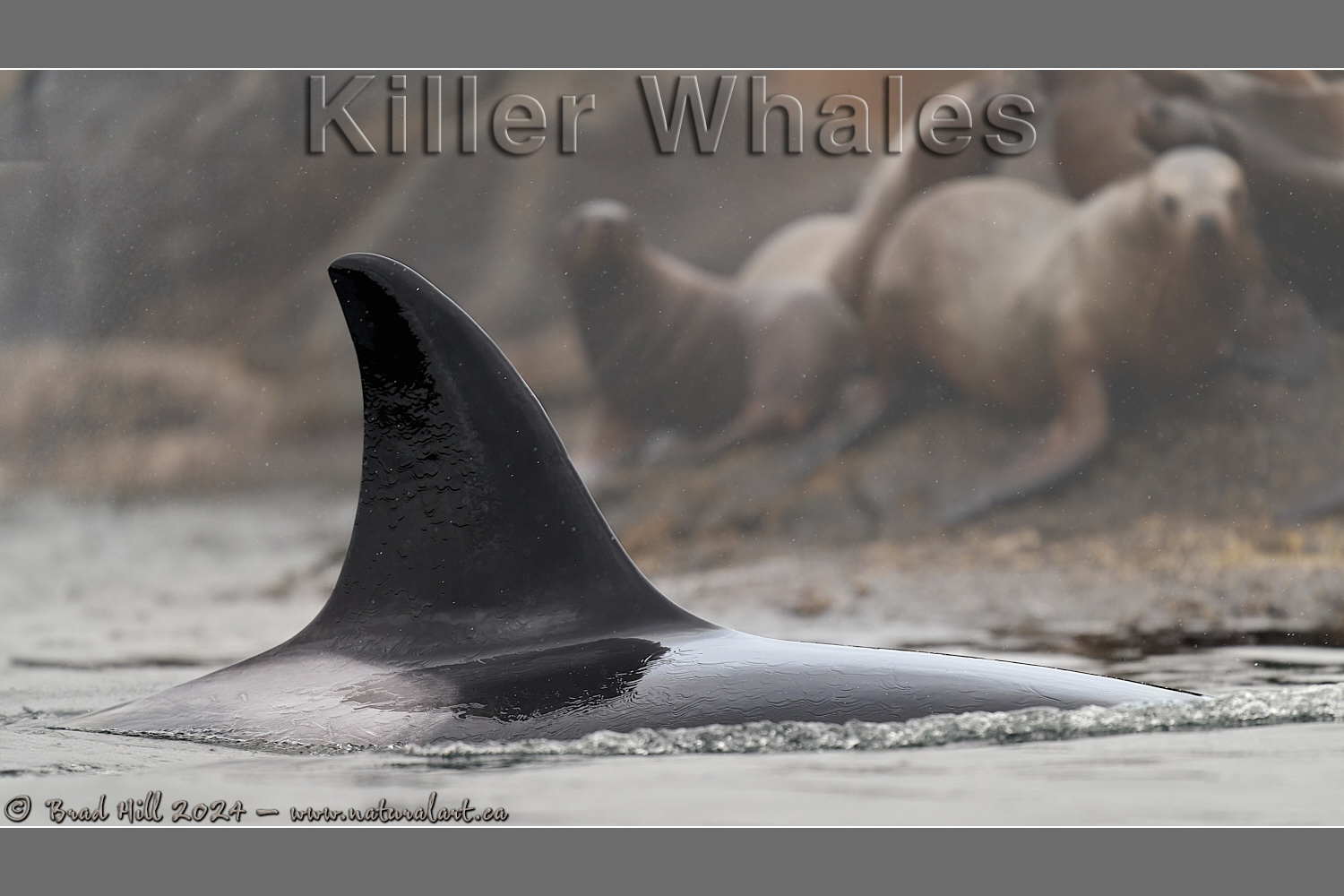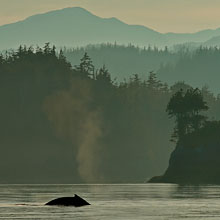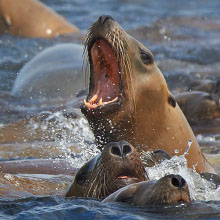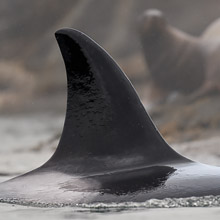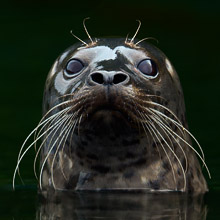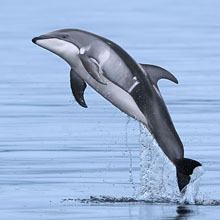Availability: Undetermined - Enquiries?
In the Field
The Fin of Fear. Great Bear Rainforest, British Columbia, Canada. September 23, 2023.
View additional Killer Whale images beginning here: Killer Whales
During my September 2023 "Into the Great Bear Rainforest" Exploratory Photo Adventure we were lucky enough to witness and photograph a small pod of transient Killer Whales as they attacked a colony of Steller Sea Lions on a haul-out rock. Transient Killer Whales primarily eat marine mammals (as opposed to fish) and the sea lions are well aware of this fact. As the Killer Whales approached the colony of sea lions kicked up an amazing racket and their full attention was on the Killer Whales (and certainly not us). You could just feel the fear in the air. Of course, the sea lions that stayed up on the rocks were safe, but a few candidates for the 2023 Darwin Award ventured into the water, and one of them became a meal for the Killer Whales. It was an amazing sight to behold.
Because the highest drama in this encounter took place below the water surface I looked for another way to photographically capture the drama and "feeling" of the encounter. So I focused on "micro scenes" where the Killer Whales were above the surface with the fearful and attentive sea lions in the immediate background. I have to say that with how fast (and unpredictably) the whales surfaced and how stirred up the sea lions were it was exceptionally tough to put together the composition and photo I wanted from our Zodiac. But when I saw this one during my image culling I have to say a smile broke out on my face - it was pretty much exactly what I hoped to capture!
One technical comment about the capture of this image is probably worth mentioning. I captured this image with a Nikon Z 9 using the 3D-tracking AF area mode and with subject detection ON. But, rather than choosing "Animal" mode I used "Birds" mode. Huh? Why did I do this? Well...there's no doubt that with some mammal photography the Z 9's (and now the Z 8's) "Animal" mode out-performs "Birds" mode (which should be a surprise to very few). However, I have found that with almost all marine mammals - and when almost any mammal is very small in the frame - the "Birds" mode grabs the subject and shifts to the eye or head region better than does "Animal" mode. And "Birds" mode certainly grabs the dorsal fin of whales - as well as their tails - MUCH better than Animal mode. Take home lesson? Just this - don't assume that "Animal" mode will outperform "Birds" on all mammals you are photographing. And don't be afraid to switch between these two subject detection modes to see which works best for the mammal shooting scenario you find yourself in!
The post-processing of this image involved some challenges as well. As the image shows, the conditions at the time were quite crappy...with a lot of light rain and flat light. Prior to adjusting the image the background sea lions were very dark and tonally almost "equivalent" to the Killer's dorsal fin, resulting in a pretty chaotic scene where one's eye didn't know where to go first. So, I used some "digital tricks" in Capture One that I know to "subordinate" the sea lions in the image (and thus encouraging any viewer's eye to go to the fin first). I did this by enhancing the mist between the fin and the sea lions (which involved a selective edit where I used both a curves adjustment and some "negative" dehaze to flatten out the contrast in the background).
Anyway, it was a fascinating encounter to witness and I'm more than happy that I came away with this image to remember it by!
Here's a larger version (4800 pixel) of these stressed out sea lions and Killer Whale:
• The New Kid On The Block: Download 4800 pixel image (JPEG: 2.7 MB)
ADDITIONAL NOTES:
1. These images - in all resolutions - are protected by copyright. I'm fine with personal uses of them (including use as desktop backgrounds or screensavers on your own computer), but unauthorized commercial use of the image is prohibited by law. Thanks in advance for respecting my copyright!
2. Like all photographs on this website, these images were captured following the strict ethical guidelines described in The Wildlife FIRST! Principles of Photographer Conduct. I encourage all wildlife photographers to always put the welfare of their subjects above the value of their photographs.
3. This image was captured during my Into the Great Bear Rainforest Exploratory Photo Adventure in the early autumn of 2023. Each year I offer trips into two different parts of the Great Bear Rainforest as well as two tours into the Khutzeymateen Grizzly Sanctuary (to photograph grizzlies, of course!). Details about these trips can be found on the Photo Tours page of this website.
4. Alert: This image arguably crosses the line from simple digital correction to digital manipulation. After processing the raw file in Capture One I used "Generative Expand" in Photoshop to add about 250 pixels (on the full-sized high res master file) to the top of the image.
Behind the Camera
The Fin of Fear. Great Bear Rainforest, British Columbia, Canada. September 23, 2023.
High Efficiency* Compressed RAW (NEF) format; ISO 1600.
Nikon Z 9 paired with Z Nikkor 400mm f2.8 TC VR S @ 560mm (built-in TC engaged). Hand-held from floating Zodiac. VR on in Sport mode. 3D-tracking AF area mode with subject detection on Birds mode.
1/2500s @ f4.5; -0.3 stop compensation from matrix-metered exposure setting.
At the Computer
The Fin of Fear. Great Bear Rainforest, British Columbia, Canada. September 23, 2023.
Initial noise reduction and capture sharpening on the .nef (raw) file using the DeepPRIME XD algorithm of DXO PhotoLab 7.4 Elite (using the appropriate lens/camera optical module).
Subsequent adjustments to the adjusted linear DNG file (exported from PhotoLab 7) and conversion to 16-bit TIFF file (and JPEG files for web use) - including all global and selective adjustments - made using Phase One's Capture One Pro 23. In the case of this image the only global adjustments were a tweak to the overall contrast (a Levels adjustment) and a very slight reduction in the highlights. Selective local adjustments performed using Capture One Pro's layers and masking tools. In this case small adjustments were made on 4 separate layers, with one or more highly targeted and selective tweaks to the colour balance, clarity (mid-tone contrast), structure, a tone curve tweak, a background colour saturation tweak, and a background tweak with Dehaze.
Photoshop modifications were limited to the insertion of the watermark and/or text and a 250 pixel addition to the top of the image using "Generative Expand".
Conservation
The Fin of Fear. Great Bear Rainforest, British Columbia, Canada. September 23, 2023.
Species Status in Canada*: Endangered - Northeast Pacific southern resident population; Threatened - Northeast Pacific transient population and the Northeast Pacific northern resident population; Special Concern - Northeast Pacific offshore population.
Killer Whales (Orcinus orca) have an extremely high profile in modern pop culture and have become the "poster child" of a number of conservation groups. In most areas where Killer Whales are found they show a remarkable ability to adapt to a variety of habitats - they are found in all oceans, in water ranging in temperature from below 0 Celsius to almost hot tropical waters, and will occasionally even spend significant amounts of time in brackish water or even rivers.
Because the population sizes of Killer Whales are very low and because they have a very low reproductive rate, they face immediate risk from human-related environmental disturbances, including the immunotoxic effects of toxic chemicals we pour into the oceans and to reduction in prey availability (such as salmon).
These two Killer Whales were photographed along the coast in British Columbia's Great Bear Rainforest. The Raincoast Conservation Society is fighting to protect the Great Bear Rainforest along the central and northern coast of British Columbia. This unique ecosystem harbours a strong population of many high-profile species such as Brown Bears and Gray wolves, plus many species that serve as prey for the Killer Whale. If you are looking for a meaningful way to contribute to the conservation of the Great Bear Rainforest and all its associated species, Raincoast will provide maximal "bang" for your conservation dollars.
*as determined by COSEWIC: The Committee on the Status of Endangered Wildlife in Canada












